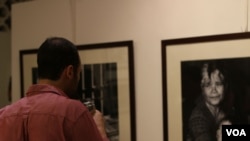French photographer Cédric Delannoy has spent the last three years in Ratanakkiri province, capturing the everyday life of the area’s indigenous people and the scenery of the mountainous province. Now he’s hosting a photo exhibit in the capital.
The collection of about 30 photographs is on display through June 16 at the Bophana Center. The exhibition launched earlier this month with the screening of a 70-minute documentary that showed how people in Ratanakkiri make a living under an EU-funded project called Annadya, which aims to promote technology and increase food security among ethnic groups in Ratanakkiri and neighboring Laotian province of Attapeu.
Delannoy, who is also the Annadya project’s field technical manager, said he wanted to show the beauty of the people and their culture. “I really love people and their faces, the way they behave, a lot of them you can see. Even the women, they smoke, so they have cigarettes or their pipes and so on,” he said. “You can see some of them are really happy, some of them are sad. You can see the emotion, and they are really true, they are beautiful. For me, it’s very important to show them. They are very different from the Khmer.”
“I had some good friendships, even if I cannot speak their language,” he said. “I cannot understand them, they cannot understand me, but [we have] these simple moments, only spending time with them doing their activities, having fun together. I know every house and everybody because I shot almost everybody in the village.”
Roughly translated, “annadya” in Sanskrit means “contentment to eat according to one’s need.” Annick Schubert, the project’s field manager said the project, which began in 2012, focuses on three areas: improvement of agricultural production and productivity, improvement of nutrition, and development of sustainable grassroots institutions.
About $3.4 million dollars went into the project, to help about 5,700 people across 64 villages and five districts.
“When we designed the project, we looked at the provinces that were most food insecure,” Schubert said. “Ratanakiri presented one of the most critical situations, because indigenous people there were in a very difficult situation. It could be Mondulkiri as well, but Ratanakkirri shares a border with Attapeu, which has a similar agro-ecological zone.”
Jean-Francois Cautain, the EU ambassador to Cambodia, and about 50 other people attended the launch of the exhibit recently. One observer, a 24-year-old English teacher from Canada, said she felt from the photographs that the people in them were connected to nature.
“They have a lot of respect,” she said. “I spoke to other people living in Banlung, and they said that Banlung is losing a lot of natural resources, because of over-development and different plantations going up. So there’s a lot of issues with the indigenous community.”








